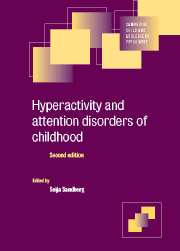Book contents
- Frontmatter
- Contents
- List of contributors
- Preface
- 1 Historical Development
- 2 Epidemiological aspects: what have we learned over the last decade?
- 3 Cross–cultural/ ethnic aspects of childhood hyperactivity
- 4 4 Sex differences and their significance
- 5 Classification issues
- 6 The role of attention
- 7 Cognitive aspects and learning
- 8 Developmental perspectives
- 9 Behavioural and molecular genetic studies
- 10 Biological underpinnings of ADHD
- 11 Psychosocial contributions
- 12 Institutional care as a risk factor for inattention/overactivity
- 13 Treatments: The case of the MTA study
- 14 Attention feficit hyperactivity disorder in adults
- Index
8 - Developmental perspectives
Published online by Cambridge University Press: 28 August 2009
- Frontmatter
- Contents
- List of contributors
- Preface
- 1 Historical Development
- 2 Epidemiological aspects: what have we learned over the last decade?
- 3 Cross–cultural/ ethnic aspects of childhood hyperactivity
- 4 4 Sex differences and their significance
- 5 Classification issues
- 6 The role of attention
- 7 Cognitive aspects and learning
- 8 Developmental perspectives
- 9 Behavioural and molecular genetic studies
- 10 Biological underpinnings of ADHD
- 11 Psychosocial contributions
- 12 Institutional care as a risk factor for inattention/overactivity
- 13 Treatments: The case of the MTA study
- 14 Attention feficit hyperactivity disorder in adults
- Index
Summary
There is a growing consensus that knowledge of normal developmental processes is essential for understanding the nature of childhood behaviour disorders (Sroufe and Rutter, 1984; Cicchetti and Cohen, 1995; Sameroff, 2000). In this chapter, developmental perspectives are brought to bear on questions concerning the ontogenesis and course of childhood hyperactivity. Despite the fact that hyperactivity is one of the most densely researched childhood behaviour disorders, its developmental precursors are poorly understood. We are only beginning to disentangle the complex tapestries of biological, emotional, cognitive-developmental, familial and social-ecological factors that mark individual pathways to this disorder and to its multiform outcomes in later life. The term ‘developmental perspectives’ refers to a rich set of concepts derived from the study of normal and abnormal development. The most basic context for understanding childhood disorders is the age or cognitive developmental level of the child. Normal processes of development involve complex quantitative and qualitative transformations in children's physical, cognitive, emotional and behavioural functioning, with increasing differentiation and hierarchical integration as age progresses (Sroufe and Rutter, 1984). Thus, atypical or ‘deviant’ development can only be defined in relation to what is known to be normal for a given age group. For example, negativism, temper tantrums and attention seeking, relatively commonplace in toddlers, would have very different meaning in school-age children or adolescents.
- Type
- Chapter
- Information
- Hyperactivity and Attention Disorders of Childhood , pp. 242 - 289Publisher: Cambridge University PressPrint publication year: 2002

